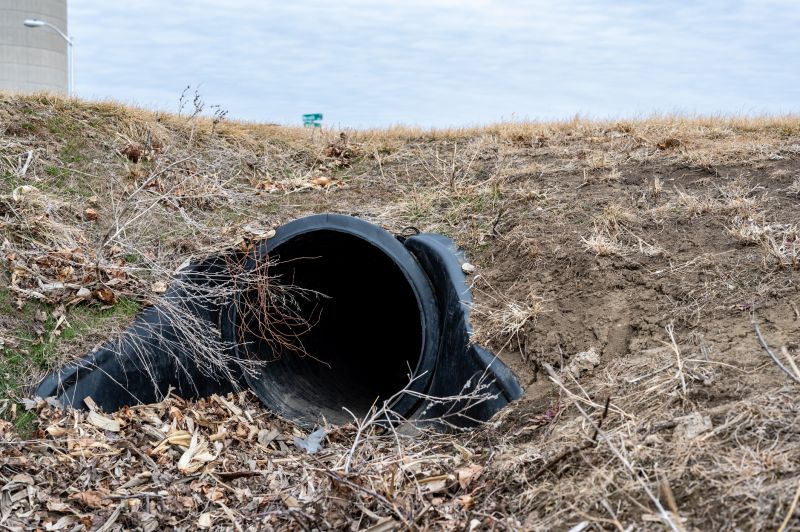Favorite Tools And Materials For Underground Gutter Drainage Work
Browse essential tools and materials favored by professionals to streamline underground gutter drainage installations and repairs.
 Underground gutter drainage systems play a vital role in managing excess water runoff and preventing water accumulation around foundations. These systems typically involve a network of pipes installed beneath the ground surface, directing water away from structures and landscaped areas. Proper installation and maintenance of underground drainage products can help mitigate issues such as soil erosion, basement flooding, and landscape damage. When selecting products for underground gutter drainage, it is essential to consider factors like pipe durability, ease of installation, and compatibility with existing drainage infrastructure.
Underground gutter drainage systems play a vital role in managing excess water runoff and preventing water accumulation around foundations. These systems typically involve a network of pipes installed beneath the ground surface, directing water away from structures and landscaped areas. Proper installation and maintenance of underground drainage products can help mitigate issues such as soil erosion, basement flooding, and landscape damage. When selecting products for underground gutter drainage, it is essential to consider factors like pipe durability, ease of installation, and compatibility with existing drainage infrastructure.
Top Overall Option
Flexible PVC Drainage Pipe System
A versatile and durable choice for underground gutter drainage, flexible PVC piping offers ease of installation and strong resistance to corrosion and cracking. Its flexibility allows for easier maneuvering through complex layouts and around obstacles, making it suitable for a variety of site conditions. Paired with compatible fittings and connectors, it forms a reliable network capable of efficiently directing water away from structures. Regular maintenance and proper installation can help maximize its lifespan and performance.
Types of Products For Underground Gutter Drainage Service
PVC Drainage Pipes
Rigid or flexible pipes made from polyvinyl chloride, commonly used for underground drainage due to their corrosion resistance and ease of installation.
Corrugated Plastic Pipes
Lightweight, flexible pipes with a corrugated surface that facilitate quick installation and are suitable for various drainage applications.
Flexible Drain Tubing
Flexible tubing options designed for tight turns and complex underground layouts, often used in retrofit or repair projects.
Drain Fittings and Connectors
Various elbows, tees, and couplings that enable secure connections between pipes and facilitate system assembly.
Inspection and Cleanout Chambers
Access points that allow for inspection, cleaning, and maintenance of underground drainage systems.
Gravel Bed Materials
Crushed stones or gravel used to surround pipes, improving drainage and preventing debris accumulation.
Filter Fabrics
Permeable fabrics that prevent soil and debris from entering drainage pipes while allowing water flow.
Trench Drain Systems
Pre-fabricated modular systems designed for installation in trenches to facilitate effective water collection and diversion.
Pump Systems
Sump pumps and related equipment used to actively move water from underground drainage areas to safe discharge points.
Erosion Control Products
Materials like silt socks and erosion mats that protect the landscape around drainage installations.
Drainage Manholes
Larger access points for inspection and maintenance of underground drainage networks.
Perforated Drain Pipes
Pipes with small holes that allow water to enter or exit, commonly used in French drain systems.
Popular Choices
Widely used for their flexibility and ease of installation in underground drainage projects.
Complete kits that include pipes, fittings, and connectors for straightforward system setup.
Essential for system maintenance, these fittings provide easy access points for cleaning and inspection.
Commonly used in French drain systems to facilitate water collection and diversion.
Popular for retrofitting or navigating tight underground spaces with ease.
Frequently selected to surround pipes for optimal water flow and debris filtration.
Commonly used for system access, inspection, and cleaning purposes.
Popular for protecting soil around underground drainage installations from erosion.
Frequently used to cover trench drains, allowing water flow while preventing debris entry.
Often selected for active water removal in underground drainage systems.
Commonly used to prevent soil infiltration into drainage pipes while maintaining water flow.
Drainage pipes come in various materials, including PVC, corrugated plastic, and flexible tubing, each suited for different site conditions and installation preferences. Connectors, fittings, and access points are also crucial components that facilitate system assembly and maintenance. In addition, gravel beds and filter fabrics are often used to enhance drainage efficiency and prevent debris infiltration. Ensuring the right combination of these products can contribute to a reliable underground gutter drainage system that effectively manages water flow.
Maintenance products such as cleanout fittings and inspection chambers are important for ensuring long-term system performance. Regular inspection and cleaning help prevent clogs and blockages, which can compromise drainage efficiency. For complex or large-scale projects, professional-grade solutions like modular trench systems or heavy-duty piping may be recommended. By understanding the various product options and their specific applications, homeowners and contractors can design underground drainage systems that meet their needs and withstand environmental conditions over time.
Key Buying Considerations
- Material durability and resistance to corrosion or cracking
- Compatibility with existing drainage infrastructure
- Pipe diameter and capacity to handle expected water flow
- Ease of installation, including flexibility and weight
- Availability of fittings, connectors, and accessories
- System maintenance requirements and accessibility
- Environmental conditions such as soil type and water table levels
- Longevity and resistance to environmental stressors
- Cost-effectiveness and overall project budget
- Compatibility with additional components like pumps or filters
- Ease of future expansion or system modifications
- Regulatory compliance and local codes
- Availability of professional installation services if needed
- System design considerations for proper slope and water flow
- Inclusion of inspection and cleanout features for maintenance
